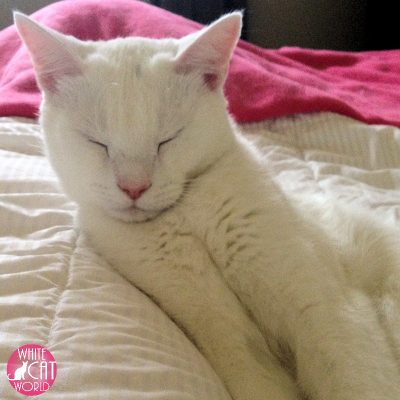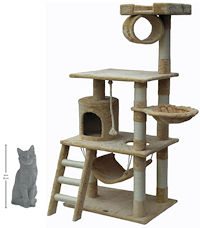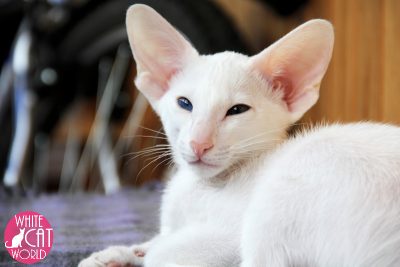 When you think about the adorable nature and endearing curiosity of your pet cat, it’s not far-fetched to contemplate the delightful relationship between humans and pet cats in general.
When you think about the adorable nature and endearing curiosity of your pet cat, it’s not far-fetched to contemplate the delightful relationship between humans and pet cats in general.
This relationship is a legacy that extends back to over 9,500 years ago. Understandably, for a legacy this long, the innate behavioral patterns and biological characteristics of cats have fueled deep-rooted speculation.
Over time, these speculations informed mythical beliefs and legends. Just as importantly, these myths were subject to changes and variations between cultures.
For the most part, these superstitions and folklore were not discriminating against specific cat colors/coats. However, in some instances, and especially in recent times, such distinctions were made.
And unsurprisingly, white cats, either for their awe or peculiarity, were the subject of some of these symbolic creations that grew in the human attempt to understand and explore our convoluted relationship with gracious white cats.
Personality of White Cats
 Hard as we may try as a modern civilization to loosen the modern conceptions dominated by superstitions and unverifiable beliefs, it is clear that the vestiges in form of stereotypes still haunt us.
Hard as we may try as a modern civilization to loosen the modern conceptions dominated by superstitions and unverifiable beliefs, it is clear that the vestiges in form of stereotypes still haunt us.
White cats, like other cats with distinct colors, have not been spared. A study by researchers at the University of California, Berkeley, showed that humans often judged domestic cats by the color of their coats. A study in the official journal of the International Society for Anthrozoology shows how feline typecasting (what we might call profiling) can have a negative impact of adoption rates.
The study found that orange cats and bi-colored cats were characterized as friendly, which improved adoption rates, while white cats, black cats and tricolor cats were regarded as being more antisocial which is where the typecasting, or profiling, hinders the adoption of cats based purely on their coat color.
White cats were considered to be more shy, lazy and calm, while tortoiseshell cats were more likely to be depicted as both more intolerant yet more trainable. Black cats were typified as having less extreme character traits, which might contribute to their mysterious reputation.
The authors of the study added that there is little evidence that supports the personality differences and stereotypes that people assign to cats based on their color.
White Cats, Blue Eyes, and Deafness
Personality is not the only factor widening the gap between white cats and loving homes. There is also the old wives’ tale that white cats with blue eyes are deaf.
To be accurate, there is some truth to this statement. But then, like with most stereotypes, the issue is with the generalization.
Of course, the majority of white cats with at least one blue eye are deaf. But, there are about 20-40% of white cats with at least one blue eye that are as normal in hearing as your average tabby. You can learn more about the weak link between white cats and deafness in our comprehensive expose on everything white cats.
Representations of White Cats around the World: Myths, Old Wives’ Tales, Folklore, Superstitions, Legends
The Americas
The Americas prior to Western Influence
The Spaniards brought domestic cats to the Americas. Before then, the civilizations in the Americas revered the bigger, wilder cousin of domestic cats native to the region—the Jaguar.
Virtually every major culture in the Americas placed the Jaguar in high esteem, similar to how the Lion was a symbol of power in Africa and the Middle East. The deification of the Jaguar occurred in regions extending from modern-day Mexico across much of Central America and south to Paraguay and Northern Argentina.
The prominent civilizations and cultures that had feline deities include the popular picks like Aztecs, Mayans, and Incans, and other lesser-known cultures such as the Olmec, Mayoruna, Andean cultures, and the Amazonian Tucano Indians.
The Americas after the Europeans Established Presence
It is perhaps ironic that the cultures that revered the Jaguar and other wild cats, such as the Puma and the smaller Jaguarundi; displayed apathy towards the smaller domestic cats.
The common belief was of domestic cats (especially black cats, but often regardless of color) being generally associated with evil and witchcraft. The Oglalas and several other Native American tribes made the red line thicker by totally having nothing to do with cats. They believed that “cats had powerful magic and the ability to curse people.”
The feelings were in reverse in the US and some other North American territories who had imported belief systems from the UK and other parts of Europe. Except that domestic cat superstitions in the US were the opposite of those in the UK.
While black cats were generally associated with good luck in the UK, black cats in the US were associated with bad luck. Therefore, white cats in the US, like in Ancient Egypt, Asia, and Russia, were associated with good luck.
Common American Superstitions and Folklore
- Dreaming of a white cat is good luck
- Seeing a white cat on the road or a white car crossing your path is considered to be good luck
- However, like in the UK, it is bad luck to see a white cat at night
Europe and Australia
While the symbolism of cats (and white cats specifically) is largely homogeneous in Asia, Europe is a mixed bag.
UK and much of Western Europe
Domestic cats have had mixed relationships with Europeans, particularly in England. Although it started with dread for black cats in the Middle Ages, the distinction thinned as the hysteria caught on.
White, black, or tricolor? It didn’t matter when paranoia reached feverish peak. The stealth, independent characteristics of cats; sudden rise in population; and increased association with poor, lonely, old ladies; made for a dangerous recipe when the persecution of witches gained steam.
Cats were deemed guilty of witchcraft by association. Even worse, they were thought to be witches in disguise during nighttime. Cats were often burned at the stake with their owners who were accused and summarily sentenced to death.
Things escalated to a point where many societies sought to make cats extinct. Thousands of cats were burned monthly in France. Thankfully, the plans fell through as King Louis XIII put a kibosh on the practice and things began to return to normal across Europe.
Some believe that the highly diminished cat population was a contributing factor to the spread of the plague.
Things did get back to normal, with black cats eventually becoming symbols of good luck and fortune. Black cats were especially valued by English sailors who thought keeping them happy at home guaranteed a fair weather when they went to sea. In fact, the belief was so strong that the price of black cats increased exponentially, such that only few sailors could afford them.
But as black cats turned from foe to friend, the reputation of white cats became only a tad less grim. White cats were seen to be emissaries of bad luck later on in England, much of Europe, and Australia. This was because white cats were believed to have the same color (white) as ghosts.
- A white cat crossing one’s path is a sign of bad luck
- Owning a white cat will lead to loss of wealth and/or plunge one into poverty
- English schoolchildren believed that coming across a white cat on the way to school was a sure sign of getting into trouble in school
- Seeing a white cat at night was a sign of bad luck
Russia
Russians had a sharp disconnect with the English symbolisms of white cats. Owning a white cat was believed to bring prosperity in Russia, unlike in England.
Norse and Celtic
The Norse and Celts also held white cats in great esteem. They didn’t discriminate based on coat color though, much like the Ancient Egyptians.
That said, the Norse goddess Freyja (also called Freya, Friyja, or Frija), the wife of Odr or Ottar, rode a chariot pulled by two white cats.
The Celtic goddess Brighid (also called Ceridwen) dispatched her two white cats to carry her commands on earth. Like her analog Egyptian deity Bastet, Brighid was the goddess of creativity, healing, and fertility (cats are famous for being promiscuous and fecund).
Brighid also means “fiery arrow,” which mirrors the interpretation of Bastet being a protector of the home and warrior goddess of Lower Egypt.
In general, white cats were believed to represent light, trust, and goodness in both cultures.
It is fitting that the cradle of mankind also doubles as the cradle of cat domestication. Although, it is generally suggested that cat domestication in Egypt occurred around 2000 B.C.E, archeologists found a burial mound of a man and his cat at Mostagedda around 6,000 years ago.
Ancient Egypt
If you are a cat person, Ancient Egypt would have been a perfect place to call home. The Egyptians revered cats, regardless of coat or eye color.
As an agrarian civilization, the Egyptians had large stores of grains that attracted mice, rats, and snakes. Cats were the ideal partners in a symbiotic relationship.
However, things morphed quickly and the status of cats in the Egyptian culture took a divine turn. The Egyptians deified the domestic cat in the feline goddess Bastet (also called Ba’at, Bast, Pasht, Pakhet, or Ubasti). Domestics cats were also believed to capture the glow of the setting sun in their eyes, and keeping it safe until morning.
Domestic cats were so revered that it was criminal to kill one intentionally or accidentally. In one account, a mob gathered to dispense justice to a Roman who had ‘accidentally’ killed a cat. Neither the plea of King Ptolemy nor the fear of Rome deterred the mob.
Furthermore, cats were often regarded as family members in a typical Egyptian family. Dead cats, whether belonging to citizens in the higher or lower classes, were often embalmed (akin to humans) and sometimes buried along with rats (to provide sustenance in the After Life). Egyptians also mourned their dead cats, sometimes going as far as shaving eyebrows.
Soldiers were often dispatched to rescue cats kidnapped by smugglers, since it was also against the law for Egyptian cats to be exported. And another telling account was of Persians releasing cats in the battlefield or having cats strapped to their shields. The Egyptian soldiers often surrendered rather than hurt the cats.

“Cats are blissfully unaware that they have only a finite time in which to finish their ‘to do’ list.”
– Jon Edgell
Nonetheless, an elaborate account of the cultural significance of white cats was when one of the Osorkon kings (widely believed to be King Osorkon II) of the twenty-second dynasty ceremoniously placed a white cat in a temple in Bubastis (the center of cat worship in Ancient Egypt) and ‘ritually endowed it with supreme power.’
Modern Egypt and rest of North Africa
Today, cats do not receive as much reverence in modern Egypt as in Ancient Egypt. But it doesn’t mean they’ve fallen out of favor altogether.
Being majorly a Muslim population, modern-day Egypt and the rest of North Africa, have as much fondness for cats, as Mohammed had.
The Prophet had a pet cat. One time he needed to head to prayers but found his cat sleeping on a sleeve of his robe. He cut off the sleeve of his robe rather than disturb his sleeping cat.
Sub-Saharan Africa
While the Ewe people in West Africa are fond of eating cats with the belief that anyone who eats cat meat (particularly the head) would get good luck. Unfortunately, there is no preference given to cat color.
An ignoble treatment, but not as fatal, from the rest of the majorly Christian population is the belief that cats are evil. Cats in general are often associated with witchcraft. Black cats seem to be worst hit (even seeing one in a dream is deemed to be a bad omen), but white cats don’t get a pass either.
Asia
In general, cats were used to ward off evil spirits in the Monasteries and mountain retreats in Tibet.
In Japan majorly, and extending to China, other parts of Asia and the Near East, white cats are “seen to bring about the happiness of its owner, along with purity, and positive energy.”
This led to the proliferation of figurines called Maneki-neko (loosely translated to “good fortune” or literally “beckoning cat”). Although maneki nekos differ in color, material used in making it, style, and degree of ornateness; white maneki-nekos are the most common.
You’d typically find maneki-nekos in Japanese and Chinese shops, restaurants, and other businesses.













[…] and foremost, let’s talk a bit about some folklore associated with the white cat. Here we go!Good Luck or Bad Luck?In some countries, particularly in England, most school children […]
[…] and foremost, let’s talk a bit about some folklore associated with the white cat. Here we […]
In ireland are white cats lucky
Hi my name is Bryant and I just became a owner of a wondering white cat, for about 3 to 4 weeeks now. All I do is feed it every day and my life just starts prospering. Money and unbelieavable opportunities start comeing my way. I feel that I well be getting of the streets very soon. Thanks for your site. God bless.
We have just adopted a white rescue cat and he is wonderful…..I feel like our home has been blessed 🙂
[…] From White Cat World […]
If is “wondering” or any animal, you cannot be the “owner”. He is your company. Good that you have time for play at the Internet, maybe you also can work?